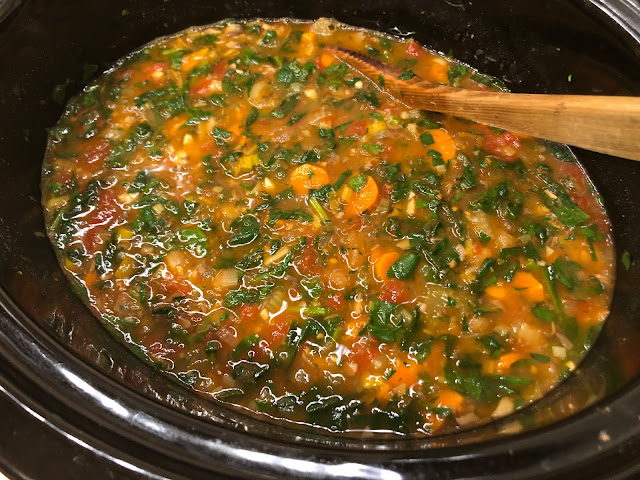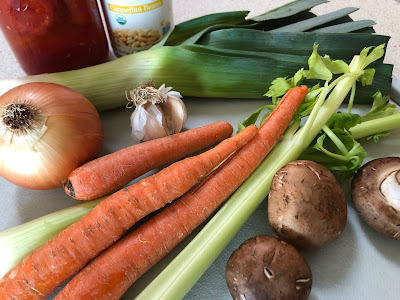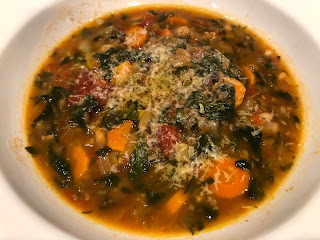
Recipe: Healthy comfort food makes the most of harvest basics
 |
| With the spinach added, the ribollita is about ready to serve. (Photos: Kathy Morrison) |
Onions, carrots, tomatoes and garlic: How basic can you get? But it's all in how they work together that makes ribollita, a delicious Italian vegetable bean soup that's perfect for fall.
Ribollita is Tuscany's version of minestrone. The name comes from the Italian for "reboiled." In other words, leftovers. Like many soups, it's even better the next day. It also freezes beautifully. I usually simmer it in my slow cooker, which is about as carefree as anything that starts with fresh vegetables. And this is my note to myself across the top of the recipe: "Double this because you'll wish you had."
I adapted this recipe from "The Slow Cook Book" by Heather Whinney (DK, 2011) and love its versatility. The vegetable combination can be tailored to personal taste. The four vegetables mentioned in my first paragraph are the only musts for this -- you'll see that there are a lot of possibilities beyond those. And don't skimp on the black pepper -- this recipe really takes to it.
This soup makes a great vegetarian supper or lunch. If you use vegetable broth instead of chicken and skip the Parmesan, it's vegan. The toasted bread adds an important texture to the soup as served, so use a gluten-free bread if you're a GF cook.

|
|
.
|
Ribollita
Serves 4 to 6
Ingredients :
2 tablespoons olive oil, plus more for drizzling
1 onion, chopped
2 or 3 carrots, peeled and sliced
1 leek, trimmed and sliced
2 celery stalks, trimmed and sliced (optional)
5 to 6 brown (cremini) mushrooms, chopped (optional)
Salt and freshly ground black pepper
2 garlic cloves, crushed and chopped
One 14-ounce can crushed tomatoes or 1 pint home-canned tomatoes, chopped
1 tablespoon tomato paste
1/2 teaspoon or more crushed dried oregano
3 cups chicken or vegetable stock, heated
One or two 14-ounce cans cannellini beans, drained and rinsed
At least 4 and up to 8 cups baby spinach leaves, shredded (one 5-ounce bag equals 8 cups)
1/4 chopped fresh Italian parsley, optional
One or two slices per serving of artisan bread such as ciabatta, pugliese or sourdough
Grated Parmesan cheese, for serving
Other vegetables that can substitute: Use 2 shallots for the leek; 1 or 2 zucchini, trimmed and sliced, instead of the celery; chard or mixed greens for the spinach.
Instructions:
Heat the 2 tablespoons oil in a large deep saucepan over low heat. Add the onion, carrots, leek or shallots and (if using) the celery and mushrooms. Cook for 10 minutes until softened but not colored. Season with salt and pepper, and stir in the garlic; cook for 1 minutes. Add the tomatoes, tomato paste, oregano and stock, and bring to a boil.
If using a slow cooker: Transfer everything to the slow cooker and adjust the seasoning. Mash half the beans with a fork, then stir them into the soup along with the remaining whole beans. Cover with the lid and cook on High for 3 to 4 hours or Low for 5 to 6 hours.
When there's about 20 minutes of cooking time remaining, check the seasoning again and then stir in the spinach. Stir in the parsley, if using, just before serving.
Toast the bread until golden brown. Place one or two pieces in serving bowls (it will depend on how big the slices and the bowls are). Drizzle the toast with a bit of olive oil, and then ladle the soup over the toast. Garnish with Parmesan and another drizzle of olive oil.

|
To cook on the stove: Keep the soup in the original pot. Follow the above directions up to the point of adding the beans. Then lower the heat, stir in only the mashed beans, and continue cooking for 30 minutes.
Add the remaining beans and the spinach (after testing the seasoning) and continue simmering for another 30 minutes.
Leftover soup, as mentioned, can be augmented and "recooked," or frozen without the bread for up to 3 months.
Comments
0 comments have been posted.Sacramento Digs Gardening to your inbox.
Sites We Like
Garden Checklist for week of July 21
Your garden needs you!
* Keep your vegetable garden watered, mulched and weeded. Water before 8 a.m. to reduce the chance of fungal infection and to conserve moisture.
* Feed vegetable plants bone meal, rock phosphate or other fertilizers high in phosphate to stimulate more blooms and fruiting. (But wait until daily high temperatures drop out of the 100s.)
* Don’t let tomatoes wilt or dry out completely. Give tomatoes a deep watering two to three times a week.
* Harvest vegetables promptly to encourage plants to produce more. Squash especially tends to grow rapidly in hot weather. Keep an eye on zucchini.
* Pinch back chrysanthemums for bushy plants and more flowers in September.
* Remove spent flowers from roses, daylilies and other bloomers as they finish flowering.
* Pinch off blooms from basil so the plant will grow more leaves.
* Cut back lavender after flowering to promote a second bloom.
* It's not too late to add a splash of color. Plant petunias, snapdragons, zinnias and marigolds.
* From seed, plant corn, pumpkins, radishes, winter squash and sunflowers.